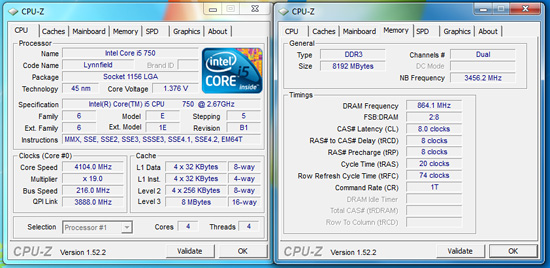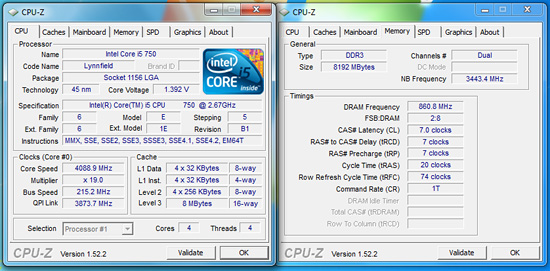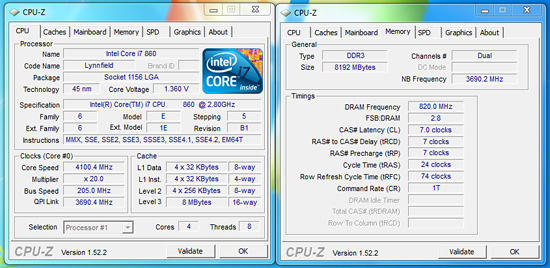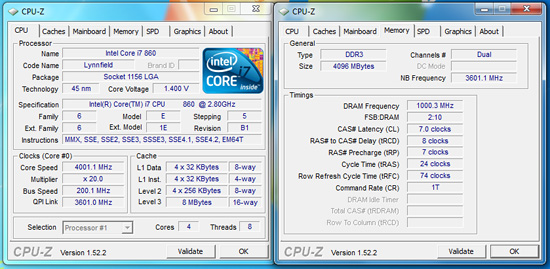Budget Micro-ATX P55 Faceoff: Gigabyte GA-P55M-UD2 and ASRock P55M Pro
by Gary Key on October 5, 2009 12:30 PM EST- Posted in
- Motherboards
Overclocking
If you are on a strict budget but still want a P55 motherboard with a full feature set that offers solid overclocking abilities, the ASRock P55M Pro is a very good choice.
Core i5/750 8GB Results

Our maximum stable overclock on air-cooling with the Core i5/750 resulted in a 4.1GHz clock speed at a respectable 216MHz Bclk with a variety of 8GB DDR3-2000+ kits. The primary voltages settings were 1.3625V VCore, 1.36V VTT, 1.80V PLL, and 1.64V VDimm. The VCore setting is deceiving. We had to run the board with Load Line Calibration (Vdrop off) enabled for stability. This was with setting the voltage manually to 1.3625V or with the Overdrive Offset enabled with +0.1625V.
This meant the VCore would rise to 1.384V~1.392V during load conditions. It was either this or run the processor at 1.425Vand accept Vdroop of 0.05V. Also, we had to relax memory timings to DDR3-1728 at 8-8-8-20 1T settings. VDimm would have to be increased to 1.71V (the next step from 1.64V) in order to run C7 settings on this board.


We could improve memory timings or speed with the Bclk set to 215 and dropping our CPU multiplier to 19, but that required a VCore increase to 1.375V as we left VTT at 1.36V along with enabling Vdrop in the BIOS. Memory had to be increased to 1.71V for C7 operation and PLL remained at 1.80V. We could run the memory at DDR3-2152 at 9-9-9-27 2T but VTT had to be increased to the next step at 1.42V and PLL to 1.94V. Performance was not measurably different from our 19x206 setting in application testing, but CPU temperatures were up 3C. Even though these settings passed our stability test suite, we just felt like the trade off in increased voltages was not worth some very minor memory performance gains.
Core i7/860 8GB Results

Our i7/860 fared better clocking wise than the i5/750, but we could not match the 21x205 speeds generated with the Gigabyte board without raising VCore to 1.425V. We ended up at a perfectly stable 20x205 setting resulting in a 4.1GHz clock speed with 8GB at DDR3-1740 at 7-7-7-24 1T timings. However, our voltage settings were lower due to the decreased clock/memory speeds.
VTT is set to 1.36V, PLL at 1.94V, VDimm at 1.64V, and VCore at 1.350V with the Overdrive Offset/VDrop enabled. Under load conditions VCore was +.015V~+.02V with Vdrop enabled and -.055V~-.06V with it disabled. Our Core i7/870 clocks matched these exactly.
Core i7/860 4GB DDR3-2400 Results

ASRock advertised DDR3-2400 speeds so we decided to verify their claim. Unfortunately, the board had serious problem running our OCZ DDR3-2400 Blade kit at 2400 with the stock 9-10-9-24 1T settings on 1.71V. We just could not dial in stability at that memory speed. We had to settle for DDR3-2000 7-8-7-24 1T timings at 1.64V. Of course, those memory speeds is more than fast enough for application usage and let’s face it, nobody will be buying this board thinking they are going to break world records.
Thoughts
The overclocking results are solid and certainly 4.1GHz speeds are fast enough for most. Let’s face it; if you have to have the best possible OC performance, then the Gigabyte UD2 board is simply better. We have no concerns recommending the ASRock board for 24/7 overclocking use. When it is overclocked, the board is very stable. As a bonus, it had no problems doing an S3 resume with the Bclk set to 215.
In regards to voltage regulation, ASRock follows Intel’s guidelines exactly. This has advantages as the processor is always running at specifications when it comes to Vdrop and Vdroop, but the disadvantage is that one has to really take time to tune the board to get the most out of it. The board was really designed to get you to about 90% of your component’s capabilities and that is it. Trying to tune another 5% performance improvement was possible, but very time consuming and frustrating to be honest.
In most cases I would not use the word frustrating, but compared to the Gigabyte UD2 board, that next five percent in tuning consumed about five times as much time on the ASRock board and we still did not match the speeds on the Gigabyte board. Granted, we are talking about numbers that look really good in screenshots and yes, application performance like encoding and file compression will show a small improvement. However, one has to ask if it is worth it.
The end story is that we would rather implement a practical overclock around 3.8GHz with the i7/860 or i5/750 at 1.275V than push to speeds around 4.1GHz~4.3GHz that require more expensive memory kits and cooling. In that context, the ASRock board is more than capable for most overclocking duties.
















55 Comments
View All Comments
yacoub - Tuesday, October 6, 2009 - link
785G is just onboard graphics halfbreed between 780 and 790 or whatever. until AMD releases a new line of high-end boards worth reviewing, why bother?haplo602 - Wednesday, October 7, 2009 - link
P55 is just half a chipset, i5 took over some of the functionality anyway ... why bother ?tommy101 - Wednesday, September 8, 2010 - link
beastyhacks79.smfnew.com the best psp hacking sitebollux78 - Tuesday, October 6, 2009 - link
Why do we need PCI anymore? I´ll tel you why: The PCI bus is more than enough for a hell bunch of applications, that´s it. If you have a damn good sound card or video capture, or whatever the card you have, and it´s PCI, you´d love to have the slot in there, because you don need to ditch that card and bet a "fantastic" PCIE x1 new card.C´mon people, let´s use the computer for the right purpose, not just to give money to the manufacturers buying new parts that you don´t
necessarily need.
I know, I´m being inflexible and oldschool, but, please, evolution is one thing, marketing is a completely different animal.
strikeback03 - Tuesday, October 6, 2009 - link
IMO it is more a board real estate problem than a case of buying the latest and greatest. On these P55 uATX boards you have 4 slots, one of which has to be devoted to graphics unless it is a headless server. If you use a dual slot graphics card (which a substantial portion of the readers on this site) you lose a second slot, and ideally you would have an open slot beneath that to ease airflow. So that leaves you with one or in a pinch two slots, therefore what interface they are is quite important. PCIe has been out on boards for what, 5-6 years now? I'd say its time to stop selling PCI cards and leave the PCI slots only on full ATX boards (plus maybe a few HTPC-oriented uATX boards) and let the interface finally die off.Though I'd say IDE has even less of a place now, SATA hard drives have been the norm for years and even optical drives for a few years. Time to upgrade if you are still carting one of those around.
sonicdeth - Monday, October 5, 2009 - link
Thanks Gary for the detailed review. Can't wait for the p55 roundup, and I'm also very interested now in your audo codec review.mindless1 - Monday, October 5, 2009 - link
... but I don't see the sense in SLI on mATX. Using the typical long video cards means you can't have a shorter depth case, just shorter height and since when is the area above your computer case a vital piece of real-estate?With 2, 8 or 16X slots onboard it only makes sense to me to go full ATX, is someone with the system budget to build a powerhouse gaming machine really poor enough, indescriminating enough, or young enough (to not have desirable cards from past systems) they don't want to add some other cards?
I hate to say it but this is getting to be a madness, the idea that we need to focus centrally on gaming ability of a board. Most people are not hard core gamers, but factually speaking, most hard core gamers don't do SLI either. Granted you can use a 16x slot for cards with fewer lanes, that seems the only saving grace for the two boards.
It's getting to the point I want a cTX case design where the drive racks are not in front of the mainboard and PSU, they are above them, so the case is even taller than std. ATX but not as deep.
Might tip over a little easier but earthquakes are rare here and plenty of other household items are more tip-happy than that would be.
strikeback03 - Monday, October 5, 2009 - link
There are cases made to hold a uATX board lying on the bottom, making it kinda a wider Shuttle. I'm personally looking for full ATX as well though, as the height doesn't matter too much to me (pretty sure anything short of a ABS Canyon or some of the bizarre decorative cases would fit under my desk) and don't want to limit my slot selection.Sunburn74 - Monday, October 5, 2009 - link
Hey Anand,Gigabyte boards have on issue that drives me nuts. As soon as you start overclocking them, you lose the ability to S3 sleep. When you do your maximal overclocks for various board reviews, would you mind testing if S3 sleep was maintained at those maximal overclocks?
Gary Key - Monday, October 5, 2009 - link
This board resumes from S3 (USB keyboard) at up to 215 Bclk (mentioned in the thoughts section, make that more visible next time) with our setup and that includes an external hard drive on the Firewire port which is properly instructed to shut down and restart.